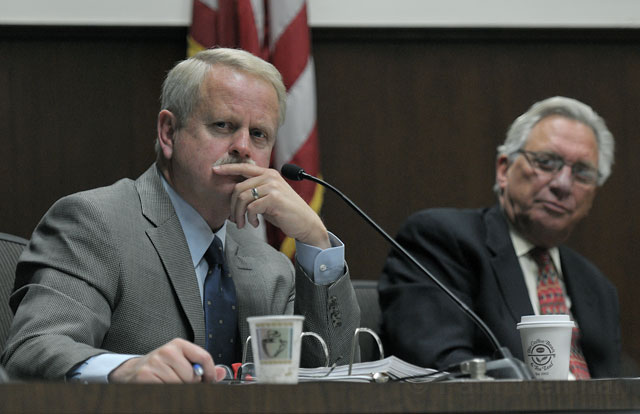$10,000 Approved For Warming Shelter, Just Barely
New Councilmember Randy Rowse Casts Decisive Vote

The short story is that the Santa Barbara City Council voted to spend $10,000 in city funds to help keep bad-weather warming shelters for homeless people — located in a number of Santa Barbara and Isla Vista churches — open and staffed with trained personnel though March 31. The longer version is that the vote, 4-3, was nail-bitingly close and the debate, vigorous. Under the previous council — dominated by a solid liberal majority — the outcome would never have been in doubt. But with the recent appointment of restaurateur Randy Rowse to fill the vacancy created when Das Williams, an outspoken progressive, was elected to State Assembly, the council majority has shifted notably to the right. Even so, it was Rowse — in his first council meeting — who cast the decisive fourth vote. He made it clear he would approve the unorthodox funding request only as “a one-time deal” and warned that warming center backers needed to seek funding through normal channels in the future. Regardless, Rowse did not vote with the council’s conservative bloc — made up of Dale Francisco, Frank Hotchkiss, and Michael Self — as many on the left side of the political aisle have been quick to assume he would.
The funding proposal was initiated by members of the Santa Barbara Unitarian Society, who have opened their downtown church to the homeless during cold and wet nights. They and four other congregations combined to provide minimal shelter from the elements for 11 nights this past December to about 40 people a night. The County of Santa Barbara donated $51,000 to keep these shelters staffed with people trained in dealing with the homeless. So far, $19,000 of that has already been spent, and Unitarians active in the effort expressed concern that the money might run out before March 31 if Santa Barbara’s nasty weather patterns persist. Last year, 32 homeless died in Santa Barbara, many on the streets. Already this year, one has been reported dead. The Unitarians, seized by a sense of urgency, secured $10,000 from the Fund for Santa Barbara; they were asking City Hall for $10,000 more.
Mayor Helene Schneider identified an intriguing source that would not impinge upon the general fund. When developer Bill Levy secured approval from City Hall to build a community of time-share condos in the Californian Hotel — then a flop-house for transients that’s long sat vacant because of seismic concerns — on the two blocks at the bottom of State Street, the California Coastal Commission, led by then commissioner Pedro Nava, insisted Levy pay a $1-million mitigation fee for the loss of low-rent visitor accommodations that the Californian afforded. For years, that money has been sitting in an interest-bearing account, and Schneider suggested taking $10,000 of the $90,000 in accrued interest and spending it on the warming shelters. “It’s not general-fund money, so it’s not like it could be used to hire police officers,” she said.
Councilmembers Hotchkiss, Self, and Francisco argued against the funding, contending, in effect, that Santa Barbara is killing the homeless with kindness. Because of the plethora of well-intentioned community organizations, they argued homeless people travel 3,000 miles across the country to Santa Barbara, drawn by more than the good weather. But the homeless come in such numbers, they argued, that they overwhelm the capacity of service providers. They end up on the streets; some die. “The tragedy we see is due to the fact that we’re trying to do too much,” said Hotchkiss. Francisco echoed that theme and insisted that the need for warming shelters was not as urgent as proponents claimed. The Casa Esperanza homeless shelter — with a capacity of 200 — and the Rescue Mission, he said, open their doors to numbers beyond their stated capacity when the weather got rough. But in an interview after the meeting, Casa Esperanza director Mike Foley said, “That’s simply not true.”
Hotchkiss, who said he was elected to reduce the number of homeless people, grilled Dr. Lynne Jahnke, a retired oncologist who is heading the warming center effort. Couldn’t volunteers do the work of paid staff? he asked. No, Jahnke answered; volunteers are not equipped to handle the paranoid schizophrenics and other mentally ill who show up at warming shelters. “These are people who choose to live on the street?” asked Hotchkiss. “How can you choose to live on the street if you’re a paranoid schizophrenic?” she replied.
Jahnke received a much warmer reception at the hands of Grant House, a strong supporter of the warming center, who likened her to Joan of Arc. “Thank you,” Jahnke replied, “but wasn’t Joan burned?”
Where Jahnke kept cool, Mayor Schneider — a strong supporter of getting services to the homeless — showed some heat. Responding to Councilmember Self’s assertion that most homeless come from out of town, Schneider urged her and others to participate in an upcoming census and questionnaire of homeless in Santa Barbara County. “Let’s find out what the true data is so we don’t get pronouncements of what we think we know because we don’t know,” she stated. Nor was Schneider receptive to the idea that the council wait to study whether the expenditure was the best use of city resources, as Councilmember Francisco suggested. “I’m not going to wait until more people die this winter,” she said, “before deciding to spend the $10,000.”



